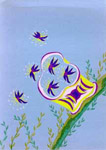
Definition of Consciousness
Webster’s New World Dictionary of the American Language defines consciousness as: “the state of being conscious; awareness, especially of what is happening around you and the totality of one’s thoughts, feelings, and impressions.”
Consciousness, therefore, encompasses our external as well as our internal reality. Cognitive science defines consciousness as a phenomenon that is explained in terms of computational or neural mechanisms such as:
- The ability to discriminate, categorize and react to environmental stimuli
- The ability to access internal stimuli
- The integration of information by a cognitive system
- The focus of attention
- The difference between wakefulness and sleep
- The deliberate control of behavior
The Western world is more apt to define consciousness as the ability to be aware of external events that are recognized by the five primary senses. On the other hand, the Eastern world is more inclined to say that one is a “conscious being” if one has the ability to be aware of inner events that are recognized by our higher sense organs.
Consciousness and Perception

The next question is, “What is the mind conscious of?” In other words, of the myriad internal and external stimuli, what do we perceive and hold in our conscious mind? Our physical conscious reality is perceived by our five senses: vision, hearing, taste, smell, and touch. However, our five physical senses are limited to a small segment of the total spectrum of light, sound, etc., and even this small segment is much more than we can consciously register. Therefore, we must filter out most of our perceptions and send them to our unconscious and our superconscious minds. Thus relegated, this information can be called upon when it is needed.
What is this filtering system? Physiologically and anatomically this mechanism is the Reticular Activating System (“RAS”). The word reticular means “net-like” and the neural reticular formation itself is a large, net-like diffuse area of the brainstem. The brain’s RAS controls arousal, attention, and awareness – the elements of consciousness itself. The brain’s Reticular Activating System manages how we interpret, respond, and react to both internal and external information. The RAS acts as a filter, similar to one on a camera or a microphone, that filters out certain frequencies of light, sound, or other perceptual stimuli. Most stimuli will be filtered out and sent to either the unconscious or the superconscious mind. The stimuli that pass through this filter will be imprinted on the conscious areas of the cerebral cortex.
Our physical senses recognize stimuli by senses as frequency and intensity. We cannot consciously perceive a stimulus that is above or below a certain frequency band. For example, we can only perceive light above infrared and below ultraviolet. The stimulus is still there, but we can only perceive it unconsciously through our first, second and lower fourth dimensional bodies or superconsciously through our higher fourth and fifth dimensional bodies.
We also cannot consciously perceive stimuli with intensity below the threshold of our physical receptors. There may be a sound at 5 decibels, but if our threshold of hearing for that sound is 10 decibels, we will not consciously hear it. We also learn to adapt to familiar stimuli. For example, some one who has lived next to a train track for years may not even notice the train going by whereas someone new to the area may perceive it as being very loud.
Experience and Consciousness
 Robert Ornstein, in his book The Psychology of Consciousness, talks about consciousness as a constructed reality. He believes that in order to create a stable, manageable environment, a sensory-filtering system develops from childhood and is continually shaped by subsequent situations. Therefore, our experience of conscious reality is actually only a representation of that which we choose to experience. Our personal history of experience creates a belief system that defines our personal reality.
Robert Ornstein, in his book The Psychology of Consciousness, talks about consciousness as a constructed reality. He believes that in order to create a stable, manageable environment, a sensory-filtering system develops from childhood and is continually shaped by subsequent situations. Therefore, our experience of conscious reality is actually only a representation of that which we choose to experience. Our personal history of experience creates a belief system that defines our personal reality.
Beliefs define our experience because they create our filters. Filters are custom- made, based upon a hierarchal system, and that which is most important comes first. How do we determine what is most important? The third dimension is based on survival. Therefore, that which is most important is that which will facilitate survival. Survival is a relative term and is dependent upon the circumstances of one’s reality. If someone is a street person, survival means finding edible food in the trashcan. On the other hand, if someone is a stockbroker, survival may mean knowing the stock market.
That which is familiar is also important. Therefore, we filter in what is familiar because it brings comfort and a sense of security. This sense of security is vital because it eases our fear. Fear is not overcome by bettering our life. Fear is a key element of third dimensional life because there is always some possibility of danger. We seek to register what is familiar because it calms our anxieties, and we are startled by what is unfamiliar because it creates a release of adrenalin and a subsequent feeling of fear.
Beliefs and Expectations
 Our belief system, which is based upon our history of experience, creates our expectations because we expect to perceive what is familiar and/or dangerous first. This expectation greatly influences our perception. A street person may not believe that he can survive off the stock market so would not “choose to” notice the newspaper article on the stock market before him. On the other hand, a stockbroker may not believe that he can survive by recycling cans and therefore may not notice the discarded can before him. Belief creates expectations and expectations direct perceptions.
Our belief system, which is based upon our history of experience, creates our expectations because we expect to perceive what is familiar and/or dangerous first. This expectation greatly influences our perception. A street person may not believe that he can survive off the stock market so would not “choose to” notice the newspaper article on the stock market before him. On the other hand, a stockbroker may not believe that he can survive by recycling cans and therefore may not notice the discarded can before him. Belief creates expectations and expectations direct perceptions.
Beliefs also create our world-view and world-views create beliefs. For example, the Western and scientific worldview believes that matter is the ultimate reality, the primary basis of existence, and consciousness is a phenomenon stemming from matter. However, the Eastern and esoteric worldview believes that consciousness is the ultimate reality and the physical universe is a projection of that. Therefore, those who believe in the Western and scientific worldview believe that only the third dimension exists, and they tune their filters to align with the frequency of the world of matter. Those who believe in the Eastern or esoteric worldview believe in multiple dimensions, and they tune their filters to encompass the frequencies of the non-material realities.
Because of these beliefs, the scientific world has focused its primary attention on the intellect with its logical, reasoning powers and the perceptions of the physical senses. Conversely, the esoteric world has focused its primary attention on inner self and the perceptions of the higher senses.
Attention and Perception

Where your attention is, there you are also. But what is attention? We can perceive many things without attending to them. There are many events that make up our conscious experience of life, yet most of them form a backdrop that is the environment in which we live. It is not until we observe our “self” focusing our attention that we become intimately aware of it. For example, we can hold a book on our lap and know that it is filled with letters. We know that those letters create words and sentences. However, until we take the initiative and choose to focus our attention upon those letters, we do not know what they say.
In other words, perception is a triangular circuit. The first point of the triangle is our sensory preceptors which carry the information to our brain. Then that perception must clear our filter for it to even be a part of our conscious environment. Thereafter, for that perception to move above the normal “wallpaper” of our world, we must impinge upon it the conscious intention of our self-awareness. It is this awareness of our self focusing our concentration upon a given stimulus which creates attention.
This “attention” differentiates:
- Knowing that there is music on from listening to music
- Hearing someone talking from having a conversation
- Noticing a birdcall from bird watching
It is this “attention” that creates learning and intimacy. We will not learn from a person or an experience unless we experience it intimately. Without a conscious sense of self it is difficult, if not impossible, to experience this intimacy. From the Western/scientific world-view “self” would mean Ego and from the Eastern/esoteric world-view “self” would mean Higher Self. As we expand our consciousness to remember our true multidimensional self, we are able to broaden our attention to encompass both world-views.
Love and Fear
 There are two feelings that also dictate our perceptions: the feeling of fear, in this case encompassing all uncomfortable feelings, and the feeling of love, in this case encompassing all pleasurable feelings. Love and fear have much to do with our development of intimacy, as we tend to move away from what we fear and move towards what we love.
There are two feelings that also dictate our perceptions: the feeling of fear, in this case encompassing all uncomfortable feelings, and the feeling of love, in this case encompassing all pleasurable feelings. Love and fear have much to do with our development of intimacy, as we tend to move away from what we fear and move towards what we love.
However, this can be very confusing because often the two feelings are intermingled. For example, we may love to ski but fear that we will become injured. We may also feel love for another person but feel that he or she will hurt us. This is where our heart chakra is called upon to assist us in following what we love without becoming lost in our fear. Also, it is our experience of conscious life that will help us differentiate from between the fear that is paranoia and the fear that is a warning.
If our personal history has been such that whenever we have allowed ourselves to move towards love we have been hurt, then it is likely that fear fills our consciousness. Therefore, our heart may be filled with fear. In this case, we may suffer from ailments that are associated with our heart chakra, and our general immune system may be compromised. That is the origin of the saying that one has a “broken heart”. It is then that we must find a way to release our history of pain and fear so that we can take the chance on love.
Often the search for love is lost in the search for acclaim, power and personal wealth. The heart chakra also rules relationships. The development of intimate, loving relationships takes time and unselfish dedication to another. It also takes an ability to deeply love ourselves for we cannot give away what we do not possess. Acclaim, power and personal wealth are not negative, but they are bittersweet indeed if we cannot share them with a loved one.
Our true fifth dimensional self is androgynous with male and female polarities living within one body. When we incarnate in the lower dimensions we must take on either a male or female body because limitation and separation are the foundations of third dimensional consciousness. While we are confined to this state of consciousness, we cannot accept the limitless experience of two polarities united within the same form. However, a part of us yearns for that reunion with our other half—our Divine Complement. We seek out relationships with others to complete ourselves but find instead that our relationships with others are mirrors of our relationship with ourselves. If we want true love with another, we must learn first to truly love ourselves.











